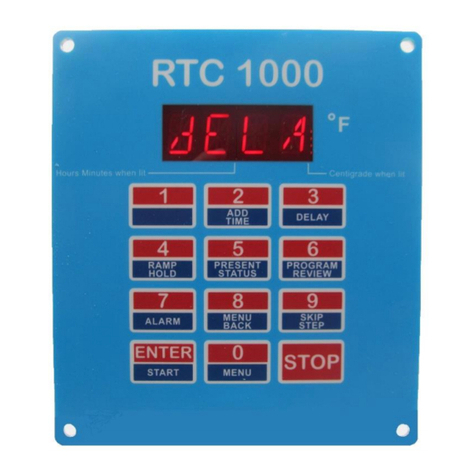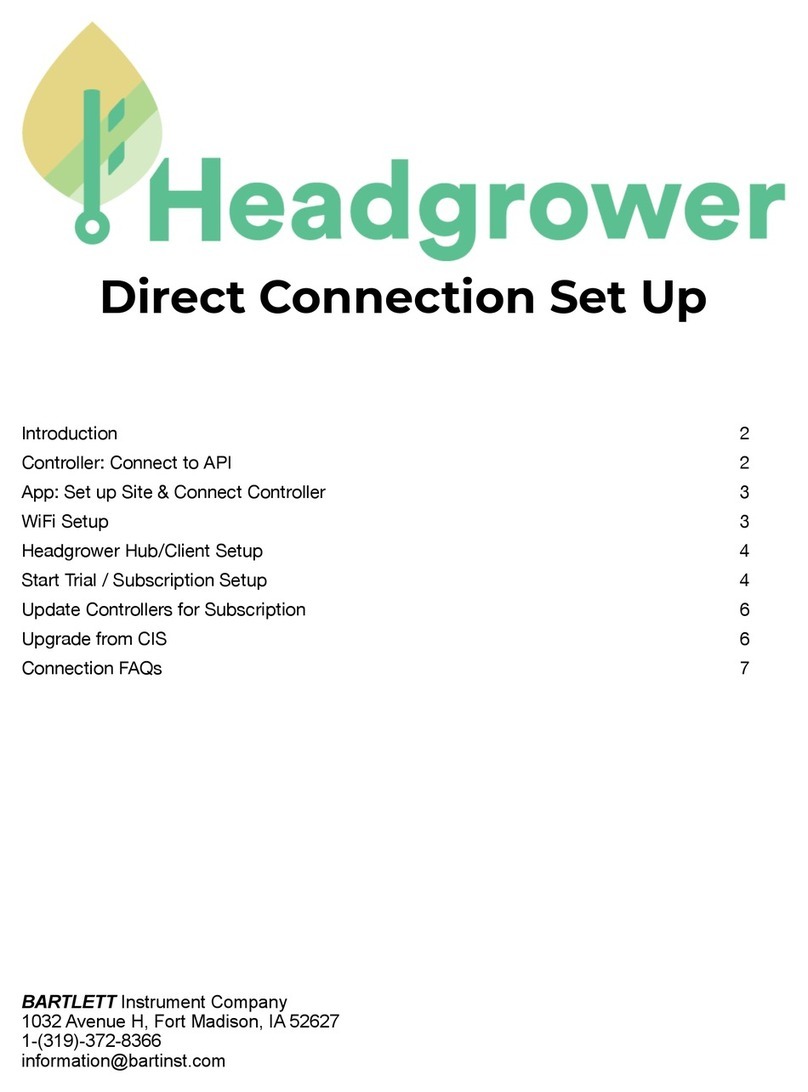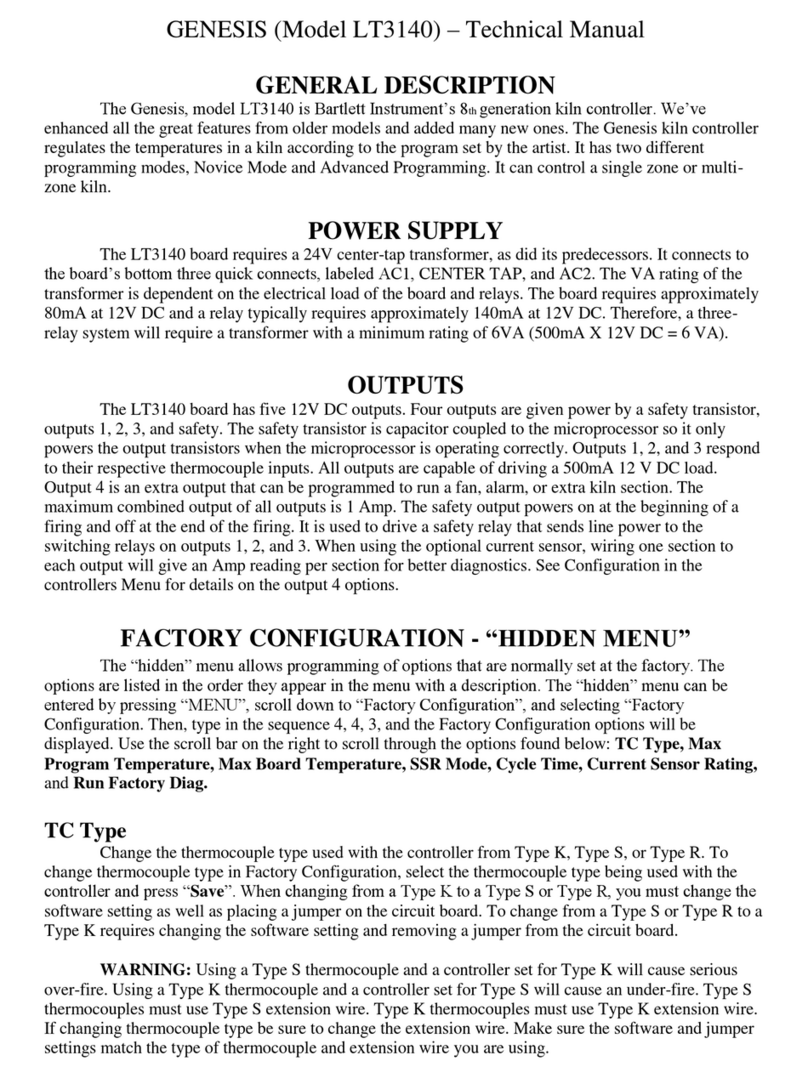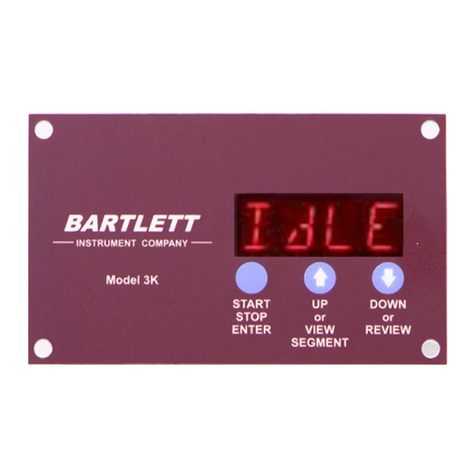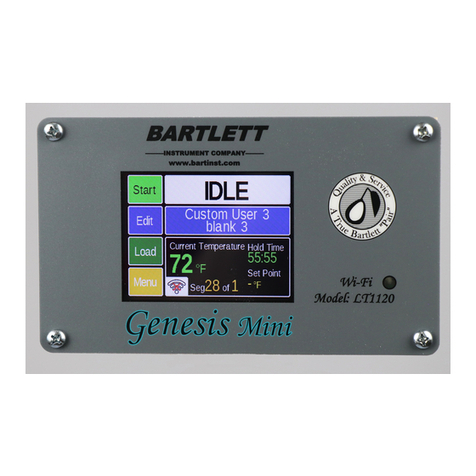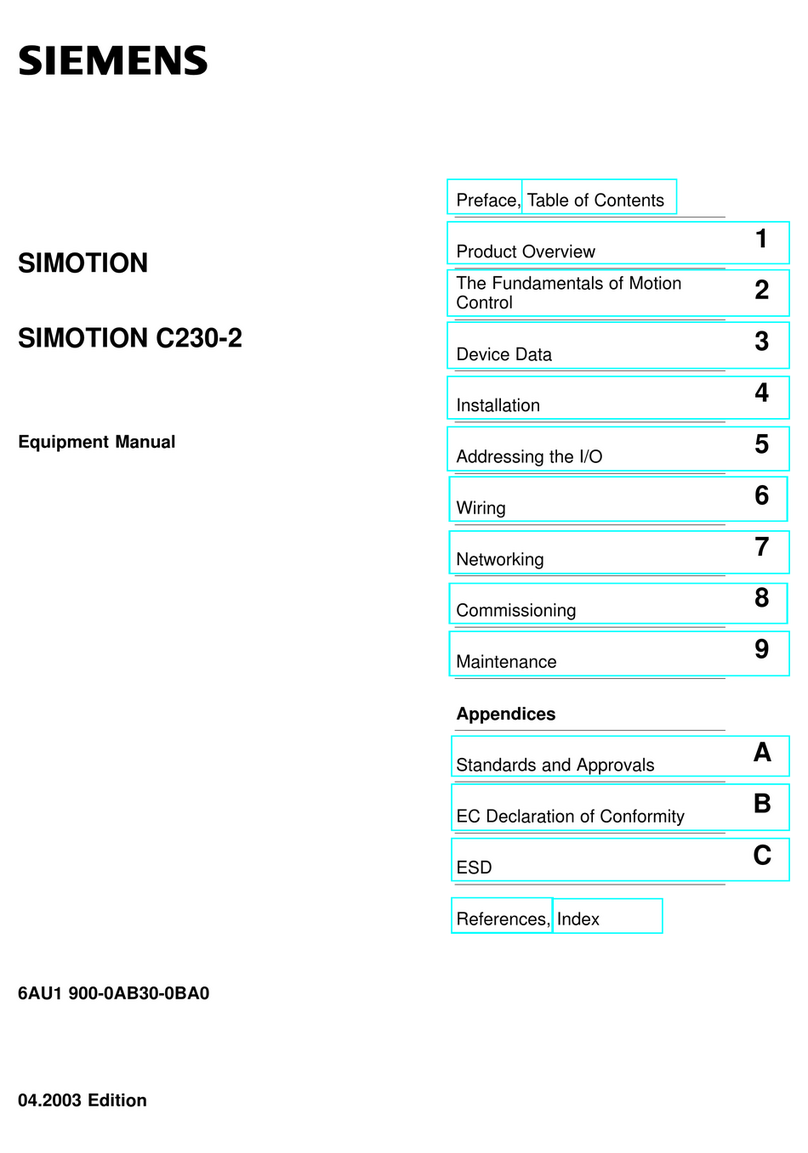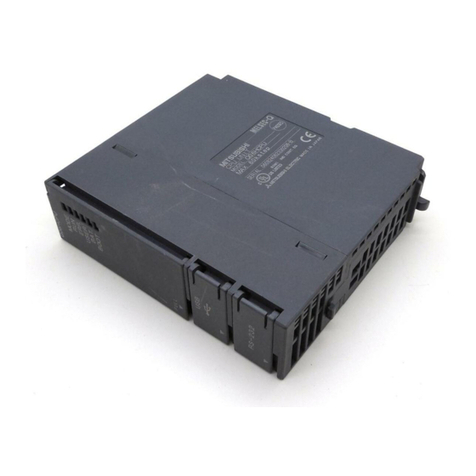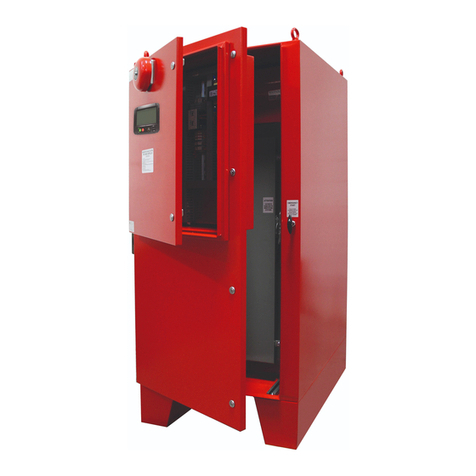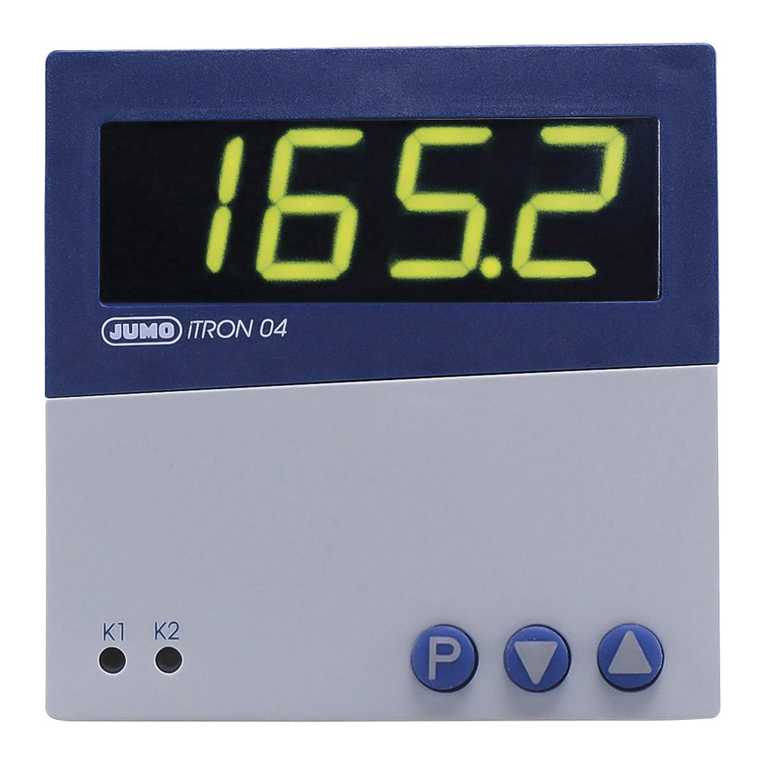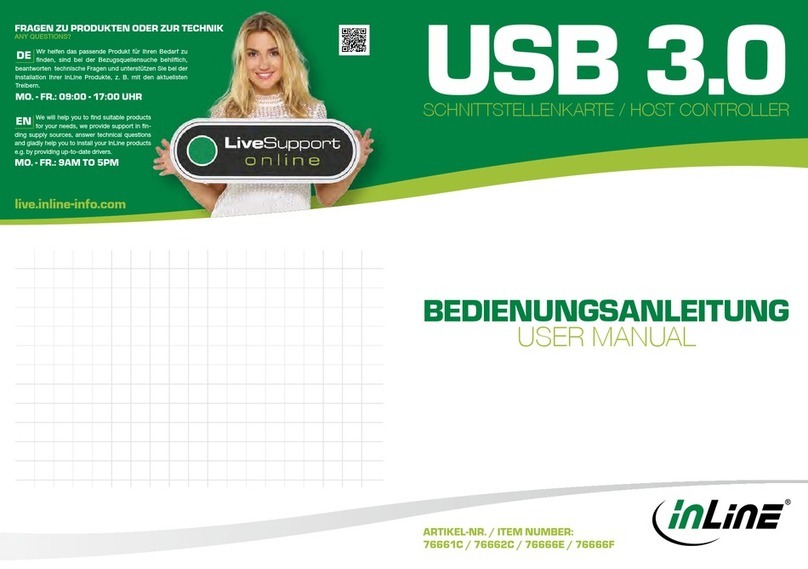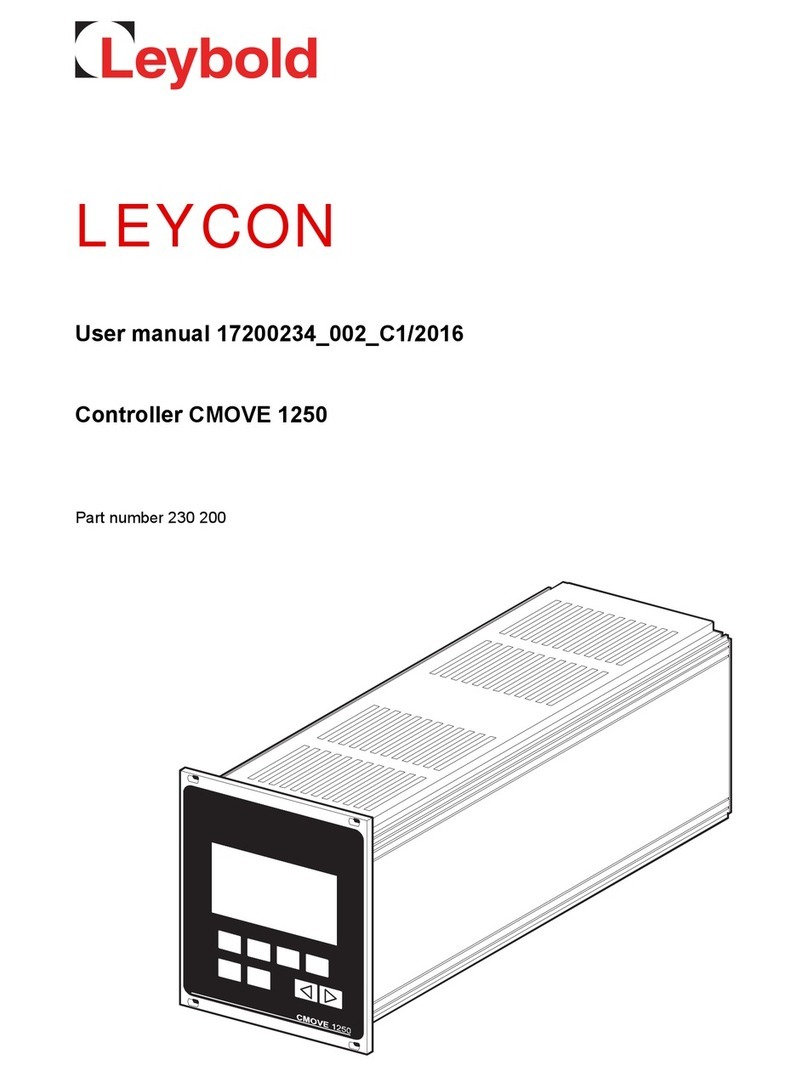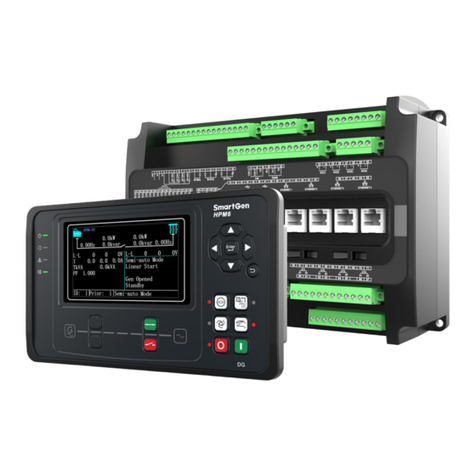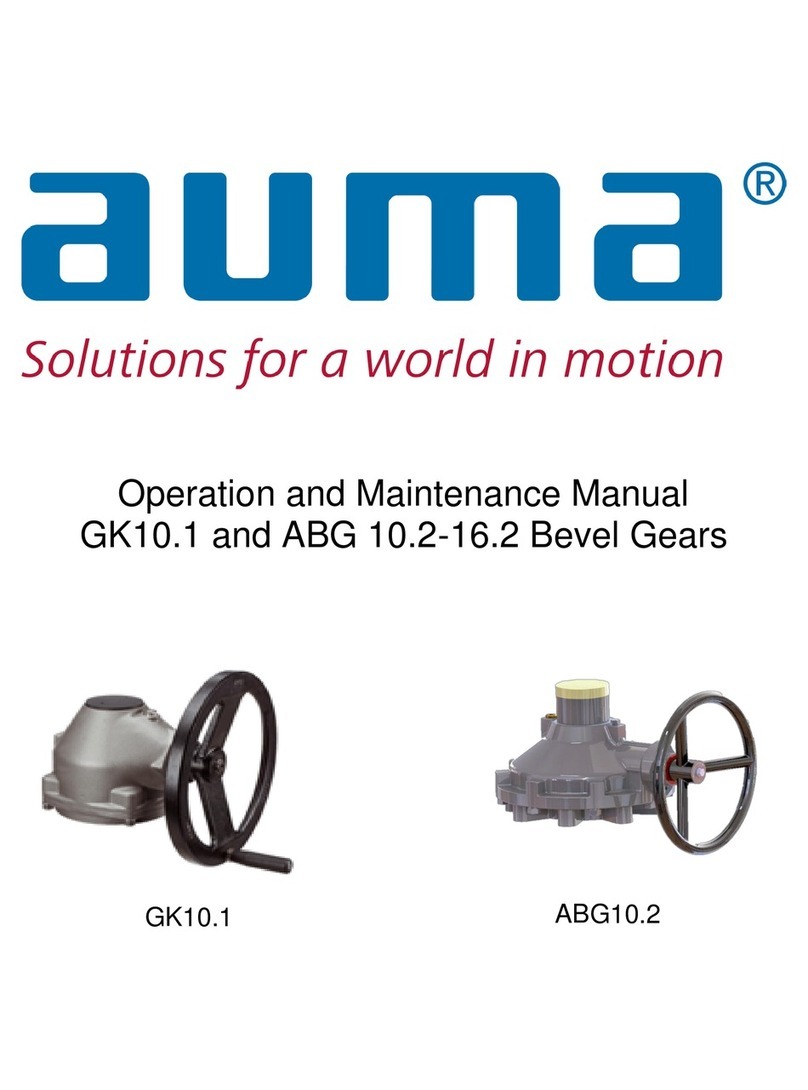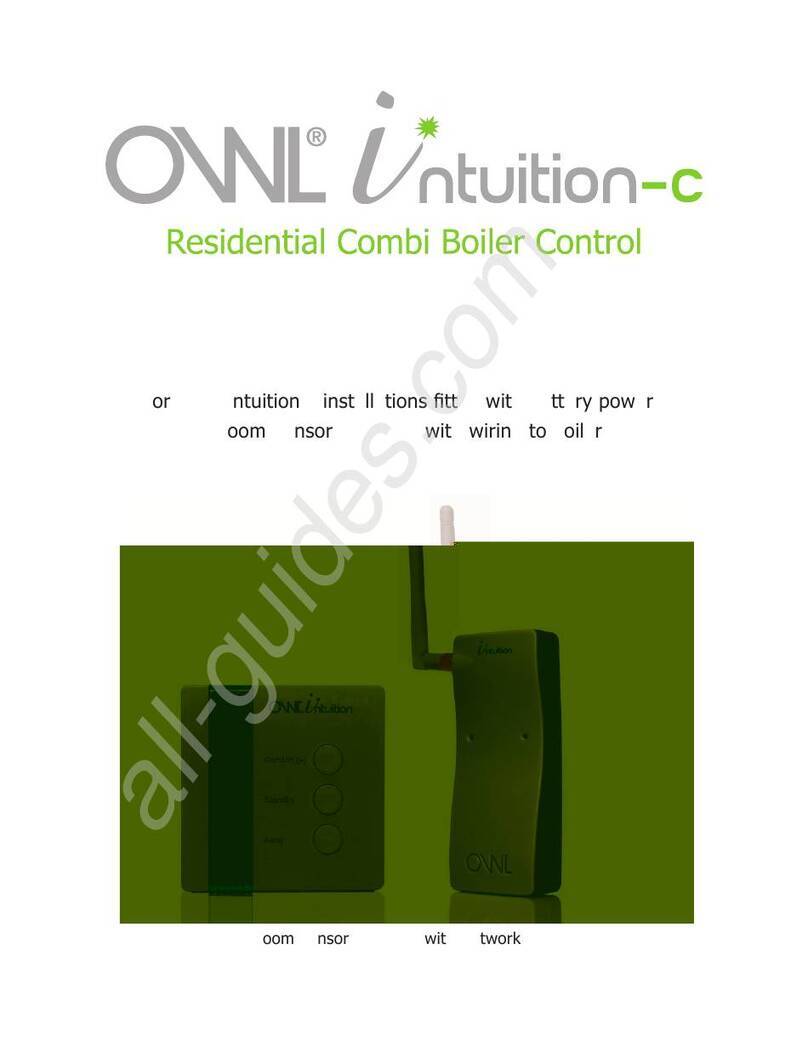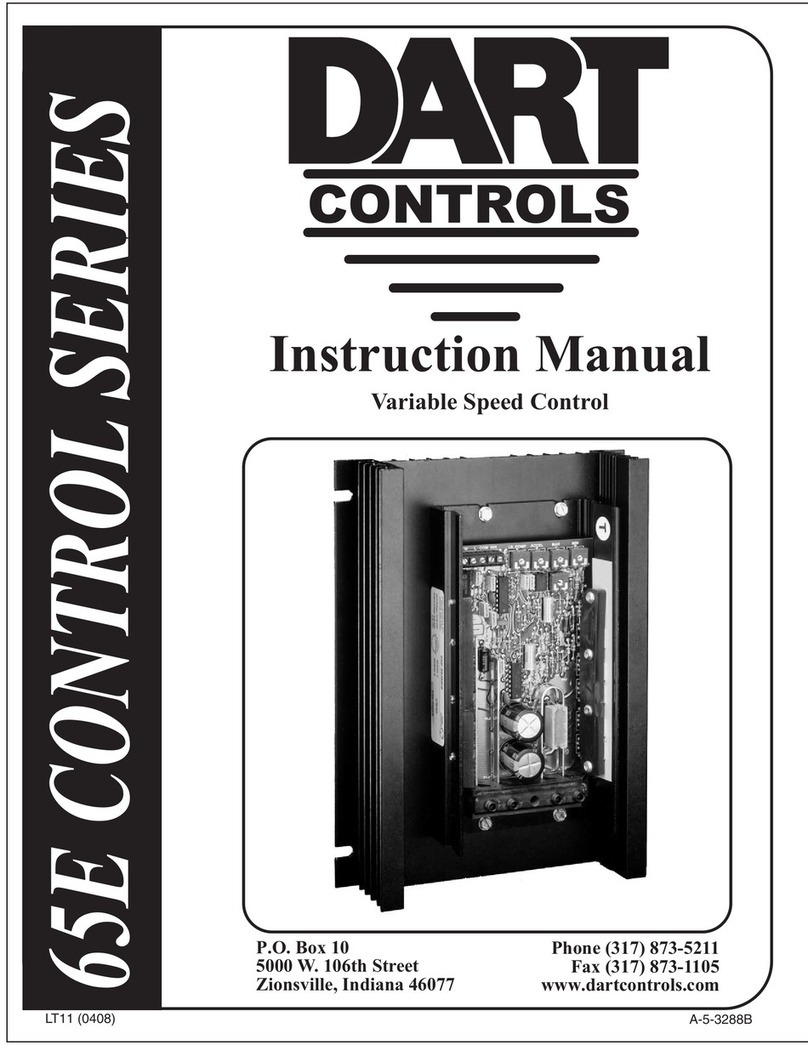Bartlett 700 Series User manual

Operation Manual
Model V6-CF
Series 700
Controller
1404 Avenue M
Fort Madison, IA 52627
319-372-8366
www.bartinst.com

1
Table of Contents
INTRODUCTION.......................................................................................................................................2
PRECAUTIONS..........................................................................................................................................2
CONTROLLER FRONT PANEL .............................................................................................................3
QUICK START...........................................................................................................................................4
FIRST FIRING OF THE KILN.................................................................................................................5
PROGRAM THE CONTROLLER......................................................................................................................5
REVIEW THE SAMPLE PROGRAM BEFORE FIRING. ........................................................................................6
START THE FIRING......................................................................................................................................7
REVIEW THE RESULTS ................................................................................................................................7
CONE FIRE PROGRAMMING................................................................................................................8
VARY-FIRE.................................................................................................................................................9
VARY-FIRE PROGRAMMING STEPS..............................................................................................................9
CALCULATING RAMP RATES FOR VARY FIRE: .........................................................................................10
WRITE YOUR OWN CONE FIRE PROGRAM...................................................................................11
START THE FIRING...............................................................................................................................11
OPERATION OF THE CONTROLLER DURING A FIRING............................................................12
END OF FIRING - CPLT.........................................................................................................................14
REVIEW THE RESULTS ..............................................................................................................................14
VIEW (INFORMATION) SECTION......................................................................................................15
CONE TABLE ............................................................................................................................................15
REVIEW PROGRAM ...................................................................................................................................15
VIEW SEGMENT........................................................................................................................................16
ONE-TOUCH INFORMATION (HOT) KEYS......................................................................................16
OPTIONS SECTION................................................................................................................................17
DELAY - THIS KEY IS USED TO DELAY THE START OF A FIRING..................................................................17
ALARM.....................................................................................................................................................17
MENU.......................................................................................................................................................18
ZONE CONTROL.....................................................................................................................................22
1. FEATURES AND ENHANCEMENTS.............................................................................................22
2. GENERAL DESCRIPTION...............................................................................................................22
3. AUTOMATIC LAG FUNCTION......................................................................................................22
4. THERMOCOUPLE OFFSETS..........................................................................................................22
5. THREE THERMOCOUPLES............................................................................................................23
APPENDIX A - CONE FIRE TEMPERATURE PROFILES.............................................................24
APPENDIX B - ERROR CODES ..........................................................................................................25
FULL POWER TEST ...................................................................................................................................26
APPENDIX C - COMMON QUESTIONS AND SITUATIONS..........................................................27
APPENDIX D - FIRING PROGRAM BLANK...................................................................................28
APPENDIX E - CONNECTION DIAGRAM ........................................................................................29

2
Introduction
This manual covers the operation of the V6-CF series 700 kiln controller. The V6-CF is a
versatile controller that regulates the temperature in your kiln so you can fire a variety of products like
ceramics, glass, or jewelry. The experienced operator can go straight to the quick start guide. The novice
can learn more about different types of firing by reading the programming sections of the manual and the
ceramics and glass introductions on our web site www.bartinst.com .
In the following pages:
First Firing steps you through the initial firing for new kilns to “season” the elements.
Controller Front Panel is a visual table-of-contents for the function of each key on the face-plate.
Cone Fire is the quick, easy method of programming for ceramics.
Vary Fire (also known as ramp-hold) is the versatile programming method for writing your own profiles
for glass, jewelry and ceramics.
The other sections of the manual will answer questions about what to expect during a firing.
Precautions
The controller is used to control temperature; it is not a safety device.
Do not operate the controller in temperatures above 125oF.
Always supervise your kiln during a firing.
The controller contains electronic components which are sensitive to static electricity. Before handling the
controller dissipate any static charge you may have by touching metal or a screw on the controller panel, the
electrical box, the kiln lid, or some other grounded object.
Always check the position of the thermocouple probe before starting a firing. The current temperature
displayed on the controller is measured at the end of the thermocouple which must be in the firing chamber
about 1” to 1-1/2”. Seal the opening around the thermocouple with kaowool or similar material if
necessary.
Always review the current program (by pressing Review Program) before firing to ensure the correct profile
is programmed.
Ensure the kiln and the areas around the kiln are clear of combustible material. See kiln manufacture’s
recommendation on required clearances.

3
Controller Front Panel
START-STOP
p. 11 LED DISPLAY
Decimal in lower
right indicates
temperature in oC.
Decim
al in middle
indicates a time.
VARY-FIRE
ENTER PROG p. 9
RECALL PROG p. 11
OPTIONS
Delay p. 17
Alarm p. 17
Menu p. 18
In Menu
RSET p. 18
PRHT p. 18 & 19
Id p. 18
16-S p. 18 & 19
CNOS p. 18 & 20
CHGo p. 18
ERCd p. 18 & 21
TCOS p. 18, 20, 21
bd T p. 18
NUMBER KEYS
for entering
temperatures and
times.
Hot Keys p. 16
CONE FIRE
p. 8
Create your own
custom cone fire
program p. 11
VIEW p. 15
Cone Table p. 15
Review Program p. 15
View Segment p. 16
Hot Keys p. 16

4
QUICK START
1. Read all precautions before using your controller.
2. Apply power to the kiln/controller
3. Clear the display and get to the idle mode by pressing ENTER.
4. Program the controller.
5. Review the program before firing to ensure the correct program is ready to fire.
6. Press Start. -On- will be displayed and then the kiln temperature. The relays and elements will be
cycled on and off to regulate the temperature according to the program.
7. At the end of the firing the controller will flash the current temperature, firing time, and CPLt.
Press ENTER to return to the IdLE state.
• IMPORTANT PROGRAMMING NOTE: Before initiating a firing profile or performing any
other function, the controller must be at IdLE. Pressing the ENTER key will clear the display of
errors (E-) or FAIL.
• In most cases when programming, you will choose an option, then press ENTER to accept the
option.
• With the display flashing IdLE alternating with the current temperature, you are ready to proceed
with programming.
• The CONE FIRE mode uses a patented method to achieve correct heat-work so it is ideal for firing
ceramics. The advantage of using the CONE FIRE method is that a very complicated firing profile
may be chosen with just a few key strokes. The CONE FIRE method helps protect against over
and under firing by carefully tracking and controlling the temperature at the end of the firing as the
cone temperature is approached. The final temperature is adjusted according to the final firing
rate. For example, as the heating elements age and the heating rate slows, the final temperature
will be adjusted downward to ensure the correct amount of heat-work.
• The VARY-FIRE mode can be used for ceramics, glass, jewelry, glazes, decals, etc. It allows you
to create your own firing profiles which can be saved and used over and over.
• If there is a kiln sitter on the kiln it must be set according to the manufacturer’s directions. Insert a
cone in the sitter that is one or two cones hotter than the controller setting.

5
First Firing of the Kiln
The purpose of the first firing is to put a protective oxide layer on the elements and thermocouple.
The first firing is done without ware in the kiln that might give off fumes that contaminate the elements.
This first firing should have shelves and witness cones. The witness cones should be on the middle of the
shelf nearest the center of the kiln. The programmed cone number should match the cones provided with
the kiln. Our example calls for a cone 04 firing but if your kiln is supplied with different cones, substitute
that cone number in the programming.
The first firing should be done according to the kiln manufacture’s specifications if they are different from
these instructions.
1. Apply power to the kiln/controller. The display will show WAIT, and then go to IdLE.
2. If the display shows PF press ENTER to proceed to the IdLE state.
Program the controller.
This example is for a Fast Glaze to cone 04 with no hold time at the end of firing.
Press Fast Glaze Display will show F-GL
Press ENTER Display will show CONE/xxx
Press 0 0
Press 4 04
Press ENTER Display will show HOLd/ 0.00
Press ENTER Display returns to IdLE/temp

6
Review the sample program before firing.
Press Review Program key, the display will cycle through the following information.
Display shows Description
F-GL Firing speed, fast glaze
PRHT/0.00 Shows zero preheat time
CONE/ 04 Programmed for cone 04
°F /1945 Top temperature for cone 04
CNOS/0 Shows 0°F cone adjustment
HOLD/0.00 Indicates zero hold at the top
temperature
dELA/00.00 Indicates delay start of 0
ALRM/9999 Alarm is disabled
ERCD/ on Error detection is enabled
FIRE/xxxx Shows the number of firings done
with this controller

7
Start the Firing.
Press start to begin the firing
The display will show –ON- then the current temperature. You will hear
clicking when the relays cycle power to the elements to regulate the
temperature. This firing will take around 6 to 7 hours.
End of firing
CPLT
At the end of the firing, the display will flash between
CPLT / Firing time / kiln temperature
Press ENTER to return to
IdLE
The display will now flash IdLE / kiln temperature. You may open the kiln
when the temperature has cooled to 150°F.
Review the Results
A properly bent cone indicates that the kiln is functioning properly and accurately. The tip of the
cone will be level with the top of the cone’s base when fired properly. The diagrams below will give you an
idea of a properly fired, under fired and over fired cone. Some variation from a proper bend is expected
and can be compensated for with the cone offset adjustment for each particular cone number based on test
firings.
Proper bend Under fired Over fired

8
CONE FIRE Programming
This is the quickest and easiest method to program the controller to fire ceramics. Programming
consists of choosing the firing speed and entering the clay or glaze’s cone number. The firing speed is
chosen by the type of firing and thickness of the clay. The bisque firings include water smoking and
carbon burn-out stages. The glaze speeds allow for faster firings. All 4 speeds will calculate the firing
rate at the end of a firing and adjust the final temperature for correct heat-work. Follow these few steps to
enter a cone fire program.
Press Slow Bisque Display shows
S-bC The slow bisque speed is used for thicker hand thrown ware. The
slow speed gives extra time for release of water and carbon burn-out.
Typical firing times range from 13-17 hours depending on the cone #.
Hand built pieces may need a preheat stage.
OR
Fast Bisque Display shows
F-bC The fast bisque speed is for thinner ware that requires less time for
water smoking and carbon burn-out. Firing time is 9 – 11 hours,
typically, and depends on the cone number.
OR
Slow Glaze Display shows
S-GL Slow glaze is used for firing glaze on thicker ware or for bisquing
very thin ware. Typical firing time is 6-8 hours depending on the
cone number.
OR
Fast Glaze Display shows
F-GL Fast glaze is the fastest speed and is used for glaze firing on thin ware,
china paint firings, and decal firings. Firing times range from 4 to 5
hours
Press ENTER Display shows
CONE/xxx The displayed firing speed was accepted and now the controller is
waiting for the cone number to be entered. The x’s represent the cone
number last selected.
Press Number keys for
cone number Display shows
xxx Use the number keys to display a new cone number. Remember, cone
numbers starting with a 0 are lower temperature than cone numbers
not starting with a 0. For example, don’t mistake a cone 6 for a cone
06!
Press ENTER Display shows
HOLd/0.00 The displayed cone number was accepted and now the controller is
waiting for the hold time at the top temperature to be entered. Usually
this value is left at 0. If a time is entered the hours are to the left of
the decimal and the minutes to the right.
Press ENTER Programming complete
Display is back to Idle Zero hold was accepted and programming is complete.
NOTE - A preheat segment for drying (candling) ware can be added to any cone fire program. See
options section for PREHEAT instructions.
TEMPERTURE REACHED at the end of a cone fire program:
When the display is at IdLE, pressing Review Program, will show the heat-work adjusted temperature that
was reached. The temperature is displayed after oF in review program. This temperature will remain until
the controller is reprogrammed. Record this temperature in your log after each cone firing.

9
VARY-FIRE
The V6-CF has 6 vary-fire user programs to store and reuse. Each program has from 1 to 8 segments (2 to
16 segments if 16-S option is on). Each segment has a firing rate, a soak temperature, and a hold time.
Vary-Fire programming steps
1. Press “Enter Prog” to start Vary-Fire programming – the display will show USER/#
2. Select User number – Press a number key 1-6 then ENTER.
3. Enter number of segments – Press a number key 1-8 then ENTER
4. Enter the ramp rate for segment 1 – Type ramp rate then press ENTER. Rates of 1 thru
9999°F/hr are valid. See note for calculating ramp rate.
5. Enter the hold temperature for segment 1 – Type hold temperature then press ENTER.
Valid temperatures range from 1°F thru MAX kiln temperature.
6. Enter the hold time for segment 1 - Type hold time then press ENTER. Displayed time is
in the format hr.min. Left of decimal are hours, to the right of decimal are minutes.
7. Repeat steps 4 – 6 for each segment.
8. Enter an alarm temperature – Type an alarm temperature then press ENTER. See
OPTIONS section for more information on alarm temperature. The alarm set at 9999 is
turned off.
The following are notes to help with programming a Vary-Fire program. APPENDIXA CONE FIRE
PROFILES can be used as a starting point for a Vary-Fire program for ceramics.
Controller
has 6
programs
User 1
Segment 1
Segment 2
Segment 3
Segment 4
Segment 5
Segment 6
Segment 7
Segment 8
Each
program
has 8
segments
Each Segment has:
Ramp rate ( in degrees / hr )
Hold temperature
Hold time
Ramp rate (in degrees / hr)
Hold time
Hold temperature

10
NOTES: For Vary-Fire programming
1. The first ramp rate of any user program must be an increasing ramp which means the segment
temperature must be greater than the starting kiln temperature.
2. To ramp up or down at the maximum rate, enter a rate of 9999.
3. To program a down ramp, you enter the rate/hour then a temperature below the previous
segment’s temperature.
4. It is best to write out the firing profile that you plan to program before you begin programming.
At the end of the Operation Manual there is a blank form for writing your firing programs.
Photo-copy as needed.
Calculating ramp rates for VARY Fire:
If you want to go from room temperature to 750oF in 3 hours, here is how to calculate the ramp rate. Take
the temperature that you want to go to (750oF) minus the starting temperature (70oF - approximate room
temperature) to get the number of degrees you want to increase in 3 hours (750 - 70 = 680). Divide this
number by the time you want to get to 750 to give you the ramp rate (680oF ÷3 hrs = 227oF/hr).
If you want to add another segment to go from 750oF to 1000oF in 4 hours, the same procedure is used.
Take the end temperature minus the starting temperature (1000 - 750 = 250) and divide this number by the
number of hours to reach 1000oF (250oF ÷4 hrs = 63oF/hr).

11
RECALL PROGRAM is used to recall a previously programmed firing profile.
Example: To recall user program #5, use the following:
Step Press Display Comment
1 RECALL
PROG Alternately flashing:
USEr & 1 The controller is ready to accept the desired user number.
2 5 5 Indicates the user program selected.
3 ENTER Programming complete
Display is back to Idle User program #5 has been selected. . The current temperature then
flashes in the display.
WRITE YOUR OWN CONE FIRE PROGRAM
Writing your own cone fire program combines the versatility of the Vary-Fire program and the
heat-work calculation of a cone fire program. It is a great way to get custom heating and cooling
rates and still have the controller do the heat-work calculation to get the correct cone bend
regardless of firing rate. The steps to write your own cone fire are the same as entering a Vary-Fire
program except when you are programming the top temperature press the CONE TABLE key and
enter the desired cone number then press ENTER. The cone number and cone temperature will be
displayed in the program review. The cone temperature can be entered into any segment so you
can also have cool down segments in the program.
Start the Firing
Press Start to begin the firing The display will show -ON- then the current temperature. You will here
clicking when the relays cycle power to the elements to regulate the
temperature.

12
Operation of the Controller during a firing
The V6-CF controller eliminates much of the “babysitting” that is required with a manual kiln.
To ensure the most consistent results from one firing to the next, you should understand how the controller
operates and monitor the firing to ensure proper operation. The block diagram and flow chart show the
basic components of a kiln’s control system.
KILN
RELAY
SWITCH
POWER
PLUG
CONTROL OUTPUT TO RELAY
CONTROLLER
Sensor
(thermocouple)
TRAVELING
SET POINT
Relay off when
temperature
above traveling
set point
Relay on when
temperature
below traveling
set point
Heating element

13
The block diagram and flow chart show that the kiln control system, in its simplest form, works
like your thermostat at home – when the temperature is too cool the heater comes on; when the
temperature is too hot the heater turns off. The major components of the control system are the V6-CF
controller, thermocouple temperature sensor, relay switch, power source and heating elements. The
controller is the brain of the operation; the controller adjusts the traveling set point according to your
program, reads the temperature in the kiln, cycles the relay on or off and determines when to end the
program.
The thermocouple (t/c) sensor is the first part to inspect when loading the kiln. The tip of the t/c
should protrude 1" to 2" into the firing chamber. Next, “START” is pressed, the controller reads the kiln
temperature and uses that temperature as a starting point for a traveling set-point (also called the local set-
point). The displayed temperature is the temperature inside the kiln. You should then hear the relay(s)
start cycling on and off to keep the temperature near the traveling set point. As the firing progresses the
controller moves the traveling set-point according to the programmed firing rate. The displayed
temperature should increase with the traveling set-point and the relay will be “on” longer. This sequence
continues until the final temperature is reached and the controller turns off the kiln. The display reads
“CPLT”.
Controller Flow Chart
Step 1
Read temperature inside kiln
Step 2
Compare temperature
to
traveling set point
If temperature is above
set point,
turn relay off
If temperature is below
set point
turn relay on
Return to the top
and
repeat the process

14
END OF FIRING - CPLT
End of firing
At the end of the firing, the display will flash between
CPLT / Firing time / kiln temperature
Press ENTER to return to
IdLE
The display will now flash IdLE / kiln temperature. You may open the kiln
when the temperature has cooled to 150°F.
Review the Results
After a firing record the firing time, and load size. In your log keep any repair information. If
cones are placed in the kiln, record the amount of bending that took place.
A properly bent cone indicates that the kiln is functioning properly and accurately. The tip of the
cone will be level with the top of the cone’s base when fired properly. The diagrams below will give you
an idea of a properly fired, under fired and over fired cone. Some variation from a proper bend is
expected and can be compensated for with the cone offset adjustment for each particular cone number
based on test firings.
NOTE – An error code ( E- ) in the display indicates an abnormal end to a firing.
See the Error code section to help determine the reason for the
error code.
Proper bend Under fired Over fired

15
VIEW (information) SECTION
View Section - Contains buttons to look up cone temperatures, review programs, and view the
current segment. View Segment is also used to skip step during Vary-Fire Programs.
Cone Table- Used to look up the temperature of various cone numbers. The temperature that is
displayed is for self-supporting cones with a heating rate of 108oF/hr. To use, press Cone
Table, enter the cone number you want to look up, press ENTER; the cone temperature will
be displayed then the controller returns to IdLE.
Review Program - The information displayed when Review Program is pressed varies
depending on whether you are using Cone Fire or Vary Fire. When Review Program is
pressed, each of the steps in the current firing profile is displayed one after another
changing every ½ second.
In Cone Fire Mode - The display will show the selected firing profile in the following
order:
Display shows Description
F-GL Firing speed, fast glaze
PRHT/0.00 Shows zero preheat time at 200°F
CONE/ 04 Programmed for cone 04
oF /1945 Top temperature for cone 04
CNOS/0 Shows 0°F cone adjustment
HOLD/0.00 Indicates zero hold at the top
temperature
dELA/00.00 Indicates delay start of 0
ALRM/9999 Alarm is disabled
ERCD/ on Error detection is enabled
FIRE/xxxx Shows the number of firings with
this controller

16
In Vary Fire Mode - The display will show in the following order:
the user program # (USEr)
the number of segments (SEG)
1st ramp rate (rA 1)
1st segment temperature (oF 1)
1st hold time (HLd1)
(If there is more than 1 segment, then the ramp rate, segment temperature,
and hold time of each of the other segments will be displayed in order.)
delay time (dELA)
alarm setting (ALAr)
error codes on/off (ErCd)
View Segment - only functions when a firing is in progress. View segment is used to view the
current firing segment or to skip from the current segment to the next firing ramp. When
View Segment is pressed during a firing the following 4 items are displayed in this
order, the current segment of the firing, the calculated rate, the travelling set-point
(SETP, the traveling set-point should be near the current kiln temperature), and the
circuit board temperature. If View Segment is pressed during IdLE, StOP is displayed
then the current temperature.
Skip Step (SKIP) - Skip Step is included in View Segment. The skip step feature is only
available with VARY-FIRE programs. It is used when enough heat work has been done at
the current segment and you want to immediately go the next ramp rate. To skip to the
next ramp, press View Segment, then within ½ second, press ENTER, and ENTER a
second time. If you press View Segment and do not press ENTER within ½ second, the
current segment (e. g., rA1) will continue to be displayed. Simply wait until the
temperature is again displayed and press View Segment, then ENTER within ½ second,
and ENTER again. If you press View Segment, then ENTER, then decide not to skip to the
next ramp stage, simply do not press any key; after about 10 seconds the display will return
to the current temperature.
One-touch information (hot) keys
Key to touch Description of information displayed
5 Displays the rate of temperature rise over the last 22.5 minutes of the firing. Diagnostic tool used
to check if the firing is keeping up with the programmed rate.
7 If your kiln is supplied with a current sensor, pressing 7 displays the amperage reading of each
section of the kiln during a firing. If no current sensor is connected the AMPS will read near zero.
8
Output indicator lights. This diagnostic routine uses the decimal points to indicate which section
the controller is trying to heat. The left most decimal point is the top section, 2nd decimal from left
is the middle section, and 3rd decimal from left is the bottom section. If the kiln has only one t/c
then all 3 decimals come on simultaneously.
0 Shows the elapsed time of a firing. Helps track the progress of a firing. Hours are to the left of the
decimal and minutes to the right.

17
OPTIONS SECTION
Delay - This key is used to delay the start of a firing.
Example: Program a one hour delay to the start of a firing.
Remember: The controller must be at IdLE to begin programming.
Step Press Display Comment
1 Delay Alternately flashing:
dELA and 00.00 The controller is ready to accept the delay time of 1 hour.
2
1, 0, 0
01.00 Displays the selected time. Numbers to left of decimal point are
hours, to the right of decimal point are minutes. If you type a
wrong number, press zero 4 times, then type the correct number.
3
ENTER
Current Temperature
The 1 hour delay has been accepted. The current temperature then
flashes in the display. When START is pressed the delay time will
display and count down to zero.
Caution – Make sure kiln area will stay clear and safe throughout the delay time and firing time
Alarm - This key is used to set the high or low temperature alarm. The alarm may be set before or
during a firing. When the alarm temperature is reached, a buzzer will sound. It has no other effect on the
firing.
Example: Before the start of a firing, set the alarm temperature to go off at 200oF.
Remember: The controller must be at IdLE to begin programming.
Step Press Display Comment
1
Alarm
Alternately flashing:
ALRM and #
The word ALRM and the last entered alarm temperature will
alternately flash on the display. The controller is ready to accept the
alarm temperature. If no alarm is entered within 10 seconds, the
display will return to the current temperature.
2 2, 0, 0 0200 Displays the selected temperature of 200. If you type a wrong
number, press zero 4 times, then type the correct number.
3 ENTER Current Temperature The alarm temperature has been accepted. The current temperature
then flashes in the display.

18
Menu – The menu is a list of options that allow you to add segments to a firing (PRHT, 16-S), adjust
calibration (CNOS, TCOS), change settings (CHGo, Id, RSET, ERCd), or check board temperature (bd
T). Navigate forward through the menu by pressing MENU and navigate backwards through the menu
by pressing ALARM.
NOTE: PrHt (Preheat) will only appear in this menu when a CONE FIRE program has been selected.
16-S will only appear when a Cone fire or User 5 is the selected program.
TO EXIT this menu without selecting any option, press STOP
MENU
ITEM DECRIPTION
RSET Resets the t/c offset to 0 and sets error codes to on. Press MENU until “RSET” is
displayed and then press ENTER to activate the reset.
PRHT PRHT shows in the menu only when a cone fire is programmed.
Preheat is used with the CONE FIRE mode only. When Preheat is selected, the
temperature ramps up at 60oF/hour (33oC/hr) to 200oF (93oC) and then holds at 200oF
(93oC) for the amount of time programmed. Preheat is automatically set to zero during
cone fire programming and at the end of each firing. Therefore, if a preheat stage is
desired, it must be reprogrammed for each firing and be the last item programmed before
START is pressed. SEE PREHEAT EXAMPLE ON NEXT PAGE.
Id Identification number for KISS computer interface
16-S Is only in the menu when a Cone Fire or User 5 is programmed
Connects User 5 or a Cone fire program to User 6. 16-S/on flashes during program
review when this option is enabled. See notes on next page.
CNOS Adjusts the heat-work for each cone number individually. This affects only the cone
number adjusted. SEE PAGE 20.
CHG° Switches between °F and °C
ERCd Allows the error checking of the controller to be turned on or off.
TCOS Adjusts the calibration of the temperature readings. This adjustment affects all cone
numbers and user programs. TCOS is usually used to balance a multi-zone controlled
kiln.
bd T Displaying the board temperature is a diagnostics function to check the operation of the
board. Used to ensure a FAIL message is due to a bad TC and not due to a faulty
controller. Press Menu until “bd T” is displayed then press ENTER. The temperature
measured at the circuit board will be displayed for about 1 second. If you get a “FAIL”
message and board temperature is approximately room temperature then the
thermocouple is faulty.

19
Preheat Example: Set a preheat time of 2 hours. Remember: The controller must be at IdLE to begin
programming
Step Press Display Comment
1
Menu
PrHt If PrHt does not show on the display, even after cycling through the
options, it means that CONE FIRE mode has not been selected. Exit the
menu and select a CONE FIRE speed, then return to the Menu.
2
ENTER Alternately flashing:
HLd & 00.00 Preheat has been selected; enter the time you want to hold the temperature
at 200oF (in this example, 2 hours)
3
2, 0, 0
02.00 Displays the selected time of 2 hours. Numbers to left of decimal point are
hours, to the right are minutes. If you type a wrong number, press zero 4
times, then type the correct number.
4 ENTER Display returns to current
temperature and IdLE Accepts the 2 hour preheat time. The current temperature then flashes in
the display.
16-S ( 16 segment program ) Activate the 16-segment option by pressing the Menu key to display “16-S”. Press
ENTER to accept the option. Press “1” until the display shows "On". Press ENTER to complete activation.
In the vary-fire mode, programs 5 and 6 can be combined into a 16-segment program. To combine User 5 and 6, first
program user 5 then program user 6 (each program can have from 1 to 8 segments). Next, recall user 5 then
activate the 16-segment option in the menu. Press Start and the controller will fire user 5 then it will fire user 6.
NOTE: In the vary fire mode, the first segment of user 6 must be an up ramp or the segment will be skipped.
In the cone-fire mode, a cone-fire program is connected to the vary-fire User 6 program. To combine a cone
fire program with User 6, first, program User 6 then program a cone fire. Next, activate the 16-segment option in
the Menu. This is a great way to add multiple cooling segments to a cone fire profile.
Important Note: In the cone-fire mode, the controller uses the first segment of user 6 to transition from the cone
fire program to User 6 so the first segment of User 6 is ignored by the controller. This means that when you
program the number of segments, you must enter 1 greater than the actual number of segments you need. You
then start the actual programming with segment number 2. The controller will ignore any information you enter
into segment 1 so as you program user 6 and the display shows RA 1, press ENTER, ENTER, ENTER to get to
RA 2.
NOTE: 16-S will appear in REVIEW PROGRAM if it is activated.
This manual suits for next models
1
Table of contents
Other Bartlett Controllers manuals
Popular Controllers manuals by other brands
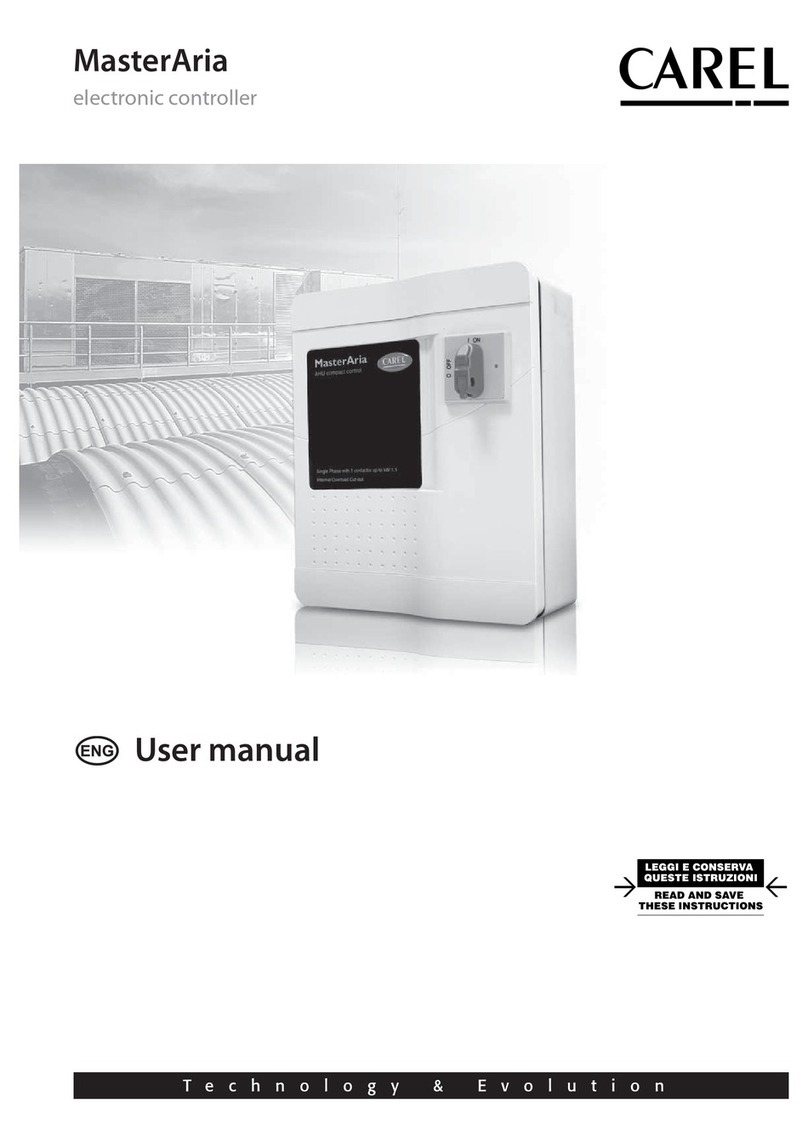
Carel
Carel MasterAria user manual
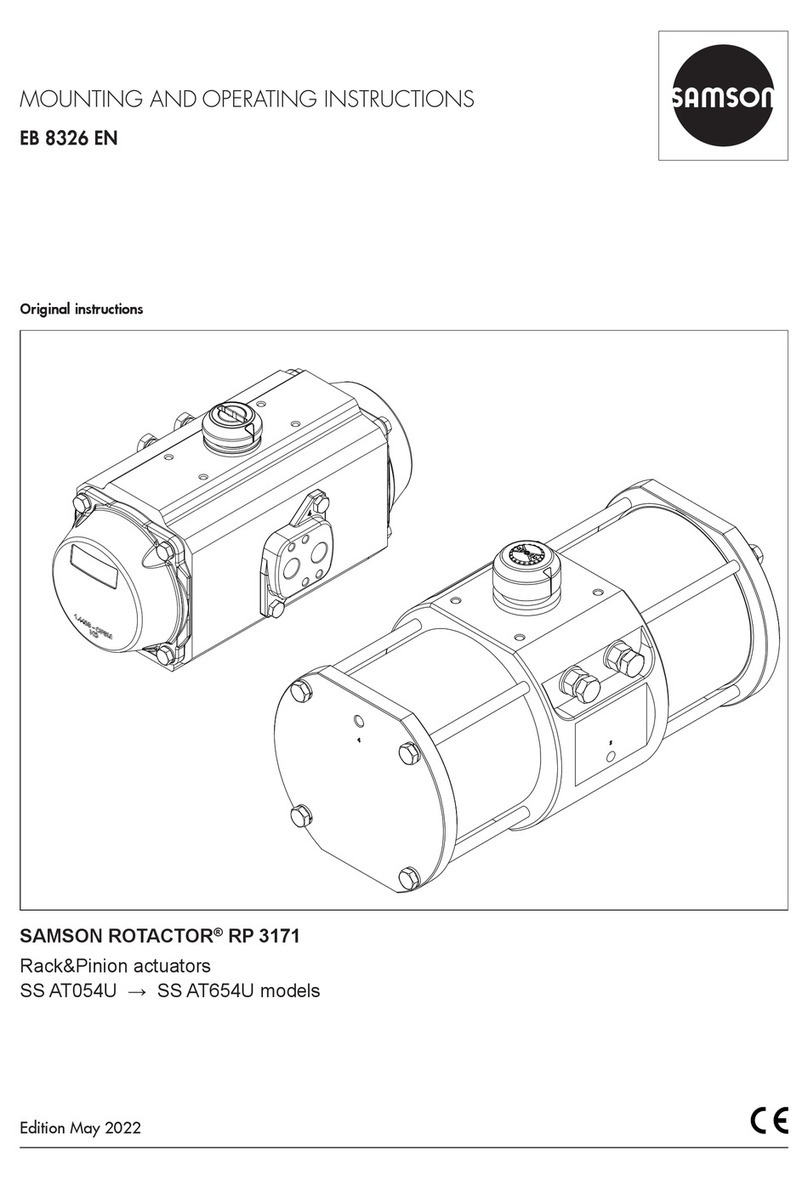
Samson
Samson SS AT054U Mounting and operating instructions
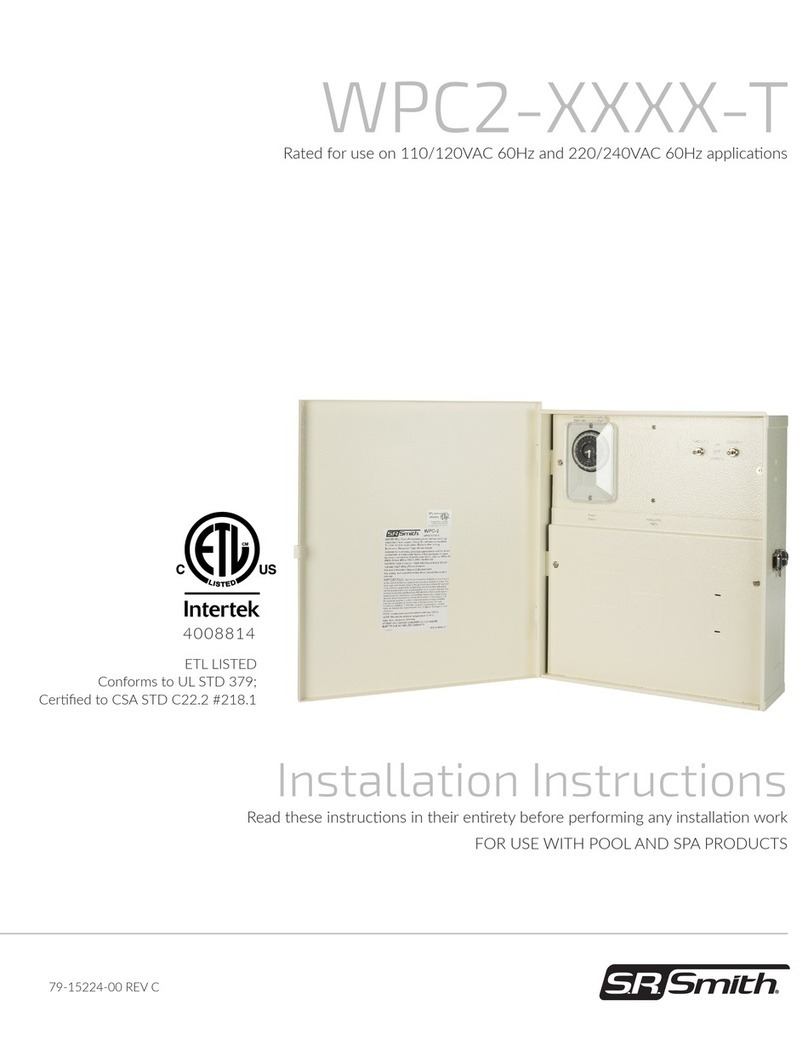
S.R.Smith
S.R.Smith WPC2 T Series installation instructions
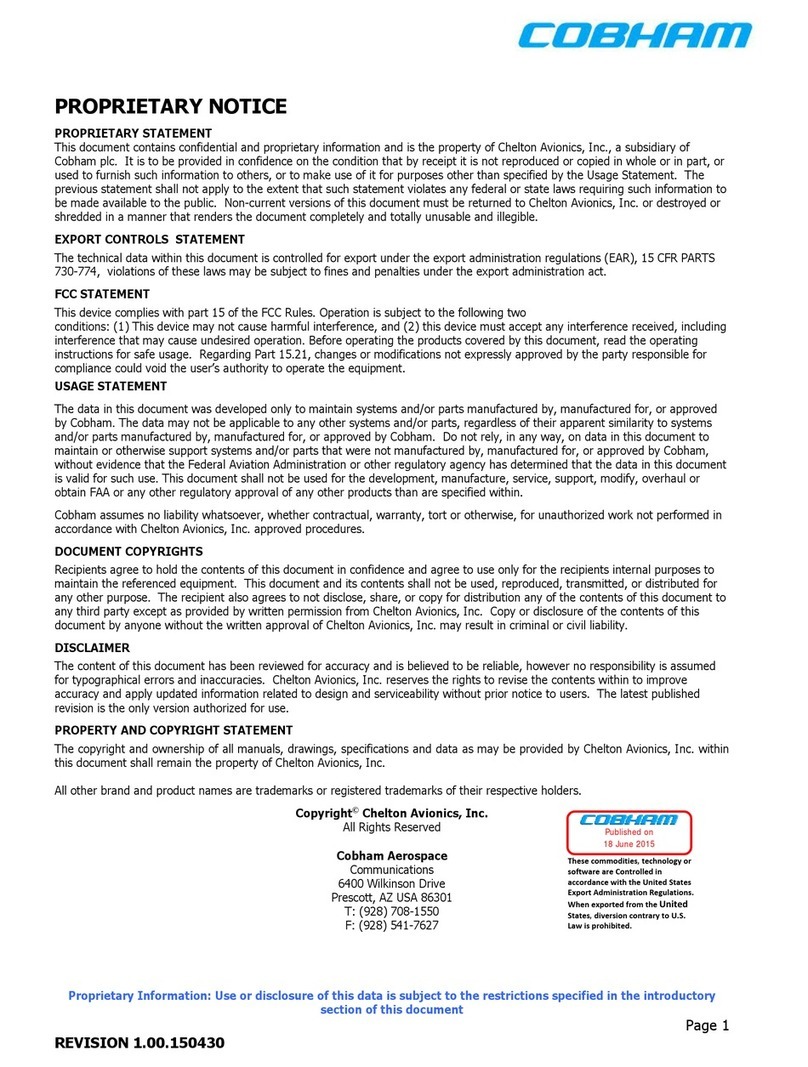
AEM
AEM SM16 Installation and operation manual
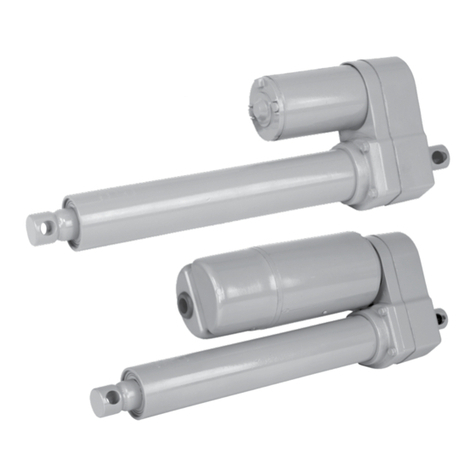
Duff-Norton
Duff-Norton TAC Series Installation, operating, & maintenance instructions
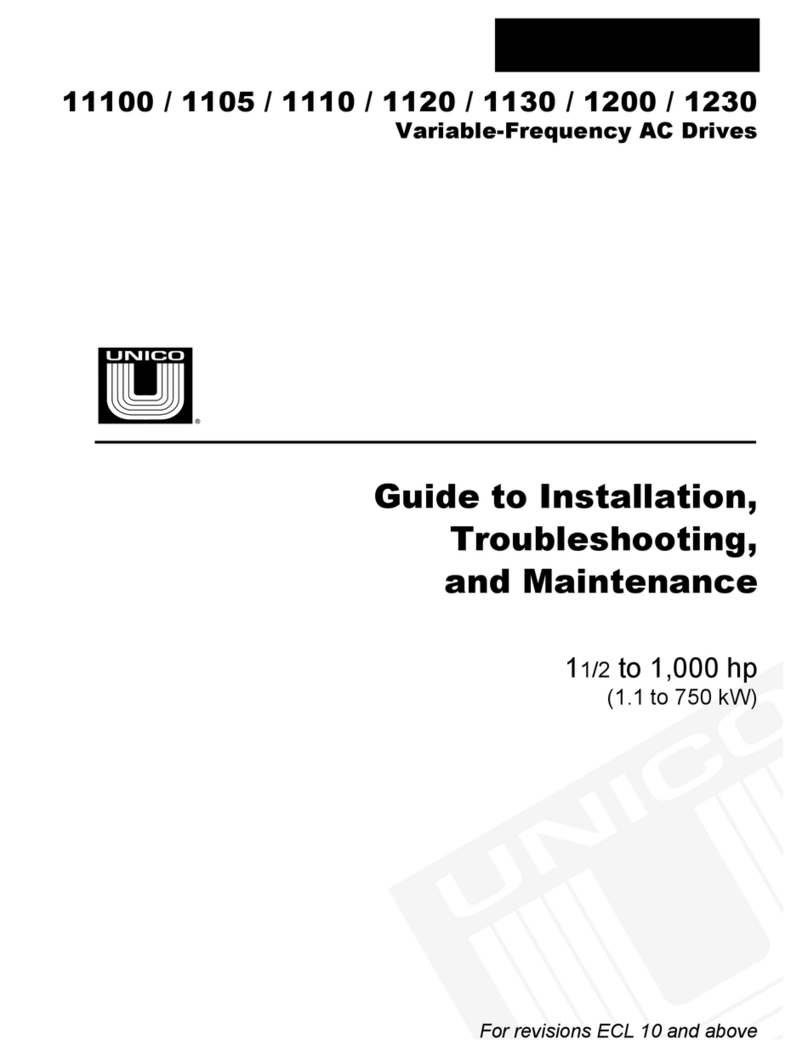
Unico
Unico 11100 Installation and troubleshooting guide
